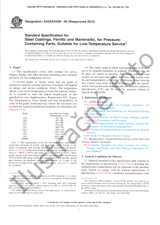Potrebujeme váš súhlas na využitie jednotlivých dát, aby sa vám okrem iného mohli ukazovať informácie týkajúce sa vašich záujmov. Súhlas udelíte kliknutím na tlačidlo „OK“.
ASTM D8068-19
Standard Practice for Collection of Culturable Airborne Fungi or Bacteria on Agar Plates by Inertial Impaction Systems
NORMA vydaná dňa 1.3.2019
Informácie o norme:
Označenie normy: ASTM D8068-19
Dátum vydania normy: 1.3.2019
Kód tovaru: NS-945346
Počet strán: 4
Približná hmotnosť: 12 g (0.03 libier)
Krajina: Americká technická norma
Kategória: Technické normy ASTM
Kategórie - podobné normy:
Anotácia textu normy ASTM D8068-19 :
Keywords:
agar plate, bacteria, bioaerosol, calibration, collection efficiency, colonies, colony forming units, culturable fungi, fungi, fungus, hyphae, impactor, indoor air quality, inertial impaction sampler, mold, mould, sampling, spore,, ICS Number Code 07.100.99 (Other standards related to microbiology)
Doplňujúce informácie
| Significance and Use |
|
4.1 This practice is intended for the collection of airborne particles on agar plates using inertial impaction for the purpose of culturing fungi or bacteria. 4.2 This practice is valuable when species level identification or quantity of culturable aerosolized fungi and bacteria are important factors for the indoor air quality investigation. 4.3 It is the responsibility of the user to assure that they are in compliance with all local, state, and federal regulations governing the inspection of buildings for fungal and bacterial colonization and the collection of associated samples. 4.4 This practice is intended to provide the user with a basic understanding of the equipment, materials, and instructions necessary to effectively collect air samples on agar plates using an inertial impactor. 4.5 This practice is intended to minimize systematic sampling variations between different data sets. |
| 1. Scope |
|
1.1 The purpose of this practice is to describe procedures for the collection of culturable airborne fungal spores or fragments or bacteria on agar plates using inertial impaction sampling techniques. 1.2 This practice does not include collection of culturable fungi or bacteria by devices not using agar plates. 1.3 This practice presumes that the user has a fundamental understanding of field investigative techniques related to the scientific process, and sampling plan development and implementation. It is important to establish the related hypothesis to be tested and the supporting analytical methodology needed in order to identify the sampling media to be used and the laboratory conditions for analysis. 1.4 This practice does not address the development of a formal hypothesis or the establishment of appropriate and defensible investigation and sampling objectives. It is presumed the investigator has the experience and knowledge base to address these issues. 1.5 This practice does not provide the user sufficient information to allow for interpretation of the analytical results from sample collection. It is the user's responsibility to seek or obtain the information and knowledge necessary to interpret the sample results reported by the laboratory. 1.6 The values stated in SI units are to be regarded as standard. No other units of measurement are included in this standard. 1.7 This standard does not purport to address all of the safety concerns, if any, associated with its use. It is the responsibility of the user of this standard to establish appropriate safety, health, and environmental practices and determine the applicability of regulatory limitations prior to use. 1.8 This international standard was developed in accordance with internationally recognized principles on standardization established in the Decision on Principles for the Development of International Standards, Guides and Recommendations issued by the World Trade Organization Technical Barriers to Trade (TBT) Committee. |




 Cookies
Cookies
